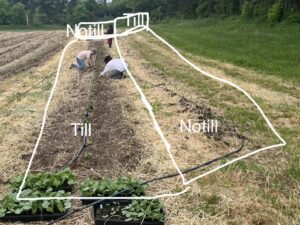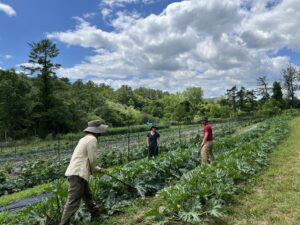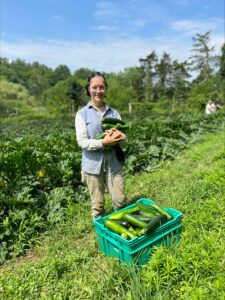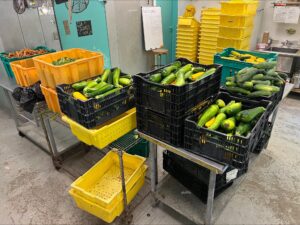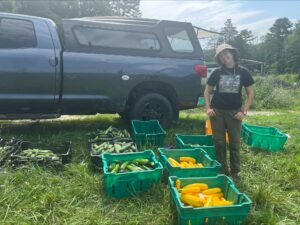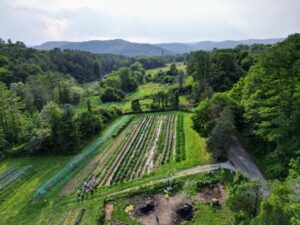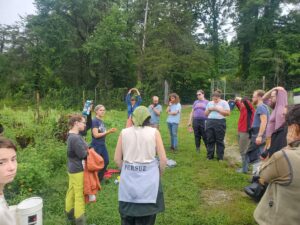Final report for FNE24-099
Project Information
The purpose of our project was to compare labor required, yield, and soil health indicators in tilled sections of cucurbits planted into overwintered plots with sections that were not tilled but rather flail mowed and broadforked before planting. We prepared two opposite halves of two 200' long beds differently and then planted zucchini into them- one having its rye, vetch, clover cover crop mowed and tilled, the other having it flail mowed and broadforked. We compared the labor time for bed prep, planting, and weeding as well as yields and soil health indicators via a Comprehensive Soil Health Assessment through Cornell's Soil Health Laboratory. In a separate field, our attempt to use similar methodology on a winter squash plot was derailed by a broken tractor at the time of planting but we were able to measure labor required for that portion of the project. Our results from the project showed a similar labor requirement for both the tilled and notill sections, with a moderate increase for the notill section in both the zucchini and winter squash plots. The yield was 20% more from the tilled section of the zucchini plot and soil health indicators were actually a tiny bit better in that section as well, though they were quite similar. Our assessment is that flail mowing overwintered cover crops and planting directly into the residue in late May may decrease yields for the season compared to traditional tillage, but more experimentation is needed.
The two objectives of this project are to determine
1) the farm production system viability of flail mowing overwintered cover crops in May and planting directly into the resulting mulch, addressing the following questions:
a) How does the labor time required for bed preparation, planting, and weeding compare between flail mowed beds and rototilled beds?
b) Are there differences in yield between the two treatments?
2) whether we can observe soil health benefits of flail mowing vs rototilling, including soil structure, organic matter, microbial life, moisture retention, and nutrient analysis. Of course, soil health benefits are tied to objective number one, because the healthier the soil the more viable a farm production system is.
Cover crops are incredibly valuable, providing organic matter, erosion protection, carbon storage, food for important soil microbes, weed suppression, nutrient storage, maintenance of relationships with crop-benefitting mychorrizal fungi, and, in many cases, nitrogen fixation. They are also in the way when it comes to getting a bed ready for planting! Rototilling is an effective and efficient way to transition from cover crops into beds that are ready to receive young seedlings, but over-reliance on the practice has many detrimental effects to the environment and to farm productivity including soil loss to erosion, disturbance of microbial life, loss of soil carbon, and damage of soil structure (see citation #1, relevant Iowa State extension bulletin). We have seen these negative effects first-hand on our farm where we have traditionally grown lots of lush cover crops and rototilled them to integrate into the soil. So, it is a conundrum for farms like ours that do not want to forsake the incredible benefits of cover cropping but also want to avoid the negative impacts of rototilling, especially when we are organic and cannot rely on chemicals to kill cover crops.
We have found many ways to reduce tillage on our farm in general- tarping, hand removal of plants, and working with winter kill cover crops. None of those methods are appropriate though for our summer planted crops, including cucurbits, that go in the ground after the last frost, some time in May. If we use winterkill cover crops, that leaves March, April, and part of May (prime photosynthesizing weeks) without an active cover crop growing. We cannot crimp or tarp the cover crops because each of those methods take weeks for the crops to die, weeks we don't have since the date we need to plant coincides with when the rye has sufficiently lodged to be killable and for the legumes to get close to flowering so they are contributing peak amounts of nitrogen.
This conundrum and a potential solution is described on Natalie Lounsbury's Notill Veggie blog (see citation #2), "Attempting to kill a cover crop mechanically before flowering will result in regrowth. This limits the timing for organic growers, many of whom find they cannot wait until mechanical termination is possible for their first round of some cash crops. Nonetheless, these high-residue systems show a lot of potential for weed suppression, moisture conservation, and erosion reduction. In general, it is believed that rolling/crimping leads to better weed suppression and more uniform residue placement than mowing, resulting in less equipment trouble when planting the following crop. However, some reports have indicated that flail mowing of cover crops is equally effective."
We acquired a walk-behind tractor with a flail mower attachment in 2023 and we are hoping that, based on reports from other farmers in similar situations and our own rudimentary experimentation in 2023, it will be a good solution to the problem. We still have questions, however, around yield, labor, and soil health. Does flail mowing sufficiently kill the cover crops and how much does the date of mowing matter? Will planting into the flail mowed cover crops take too long to be practical? Can crops establish themselves in soil that has cover crop roots still so present? Do weeds outcompete crops after flail mowing? Will nutrient availability to crops be positively or negatively impacted by flail mowing as compared to rototilling? Are the long term soil health benefits of not tilling as high as expected?
These questions will all be addressed through the proposed research project and are incredibly relevant for farmers in our region and beyond who, like us, are seeking to find economically viable ways of transitioning between overwintered cover crop mixtures and summer planted cash crops without tillage.
If flail mowing cover crops and planting directly into them in early summer works well on our farm as measured by our data collection around yield, labor, and soil health it would have the potential to:
- Reduce the environmental risks of tilling in agriculture including releasing soil carbon
- Offer a viable alternative to the erosion caused by tillage, thus conserving soil and improving water quality that are damaged by erosion
- Improve farm productivity for farms that are currently struggling with notill strategies for preparing beds that limit their ability to cover crop or that are excessively time consuming like tarping, crimping, or hand removal.
- Improve farm productivity for farms that are currently, through excessive tillage, damaging soil structure and microbial life, the pillars of long term soil productivity.
Citations:
- https://crops.extension.iastate.edu/encyclopedia/frequent-tillage-and-its-impact-soil-quality#:~:text=Since%20tillage%20fractures%20the%20soil,moved%20or%20'splashed'%20away
- https://notillveggies.org/cover-crops-for-no-till/high-residue-for-rolling/
- https://www.notillgrowers.com/
- Frost, Jesse, The Living Soil Handbook: the No-till Grower's Guide to Ecological Market Gardening
- Mays, Daniel, The No-till Organic Vegetable Farm
- Mefferd, Andrew The No-till Organic Vegetable Farming Revolution
- https://rodaleinstitute.org/science/articles/reduced-tillage-increases-nutrient-concentrations-in-stored-winter-squash/
Adamah Farm is a three-acre organic vegetable farm in Falls Village, CT. We sell our vegetables through a 22-week CSA program with local pick-up on the farm. We also grow for the dining services of the Isabella Freedman Jewish Retreat Center, of which the farm is a part. We fundraise to subsidize distribution of our vegetables to local food pantries. Our gross sales are about $70k.
We are an educational program, hosting a residential fellowship, an apprenticeship, and day programs for kids and adults. We operate under the umbrella of a national environmental nonprofit called Adamah.
We have been in operation since 2001 and Janna has been the Farm Director since 2011, after eight years of vegetable farming elsewhere. We have been committed to regenerative growing practices throughout operation, cover cropping heavily and soil testing often. We have been experimenting with no-till for the past eight years. It has been a journey of many trials to shift the farm toward what it is now about half to two-thirds notill. We have integrated the use of tarps, broadforks, crimping, flail mowing, power harrowing, living mulch paths, and mulching to ease off of soil disturbance on the farm.
We received a SARE grant in 2015 (FNE12-736) at the beginning of our efforts to reduce tillage looking at planting cabbage into hairy vetch. While our experiment design, specific goals, and personnel are all different at this point, the effort remains the same- to ease off tillage in as many aspects of our farm as possible without reducing our commitment to cover cropping, yield, or efficiency.
We have access to the following resources useful for the project:
berta flail mower on grillo walk behind tractor
broadfork
compost
seedling production space
rototiller
beds that have already been planted to cover crops
Cooperators
- - Technical Advisor
Research
May 2024:
- Started seedlings in the greenhouse for Dunja and Golden glory zucchini and butternut, tetsakabuto, delicata, and jester squash plants with Vermont Compost Fort-Vee light potting mix and soil blocks.
- Observed advanced stage of rye, vetch, crimson clover cover crop and decided it was ready for termination for zucchini plot.
- Prepared ground for zucchini planting by applying a thin layer of homemade compost and then flail mowing (with berta flail mower on grillo) half of each of two 200' beds twice (on 5/10 and 5/20), and tilling (with 5' wide rototiller on kabota tractor) the other half of each bed twice, (5/15 after brush hogging and 5/20). Broadforked notill area. Used colorful flags to mark off the experiment plots with notill and tilled area.
- Planted zucchini 5/23 at 1 row 18". Used hori hori knives in notill.
- Watered and weeded both plots.
June 2024:
- Continued watering and weeding both plots of zucchini.
- Observed advanced stage of rye, vetch, crimson clover cover crop and decided it was ready for termination for winter squash plot.
- Prepared ground for winter squash planting by applying a thin layer of homemade compost and then flail mowing (with berta flail mower on grillo) and broadforking fifteen 100' beds once (on 6/1), and tilling (with 5' wide rototiller on kabota tractor) five 100' beds once (6/10 due to tractor being broken until then). Did not flag the area because they were separated by a bed of popcorn and thus obvious which was which.
- Planted winter squash in notill beds 6/1 and tilled beds 6/12.
- Decided to record data for bed prep, planting and weeding time differences between the tilled and untilled winter squash but not the yields, seeing as the planting dates were so significantly apart (almost 2 weeks) due to tractor being broken when we needed it for tilling.
- Watered and weeded both plots throughout the month.

July 2024:
- Continued watering and weeding both plots of winter squash.
- Watered but no longer weeded zucchini as they were full size
- Harvested zucchini every other day 7/1- 8-3
August 2024:
- Flail mowed zucchini after final harvest in early August
September 2024:
- Took separate soil samples from tilled and notill zucchini plots and sent them off to Cornell Soil Health Labs for a Comprehensive Assessment of Soil Health.
- Harvested all winter squash on 9/24 but did not record any yield differences since planting timing and subsequent lack of variety parity in tilled and untilled plots would have so significantly skewed the results.
- Chose not to sample winter squash plots because by the time the squash was out, we ran out of time to sample.
Zucchini Plot
Labor
For both the notill and tilled sections of the zucchini plot we measured labor for bed prep, planting, weeding, and harvesting. The harvesting labor data is not included below because it tracked precisely with the yield data and thus was not a useful indicator for comparison, as it would make it seem like the tilled section took more labor overall, but that was simply because it yielded better overall.
| Labor : | ||||
| till | flail | date | person hrs | notes |
| x | x | 9-May | 2 | Compost Spread |
| x | 15-May | 0.5 | initial mow and then till | |
| x | 20-May | 0.25 | second till | |
| x | 23-May | 1 | planting | |
| X | 5-Jun | 3 | weeding | |
| X | 15-Jun | 6 | weeding | |
| 10.75 | ||||
| x | 10-May | 0.5 | Initial flail | |
| x | 20-May | 0.25 | second flail | |
| x | 23-May | 0.25 | final flail | |
| x | 23-May | 1 | broadforking | |
| x | 23-May | 2.5 | planting | |
| X | 5-Jun | 7 | weeding | |
| X | 15-Jun | 3 | weeding | |
| 14.5 |
As apparent in the chart above, the notill section took 1.34 times more labor hours. While the weeds were more prolific in the tilled section, we were able to hoe it, shortening the weeding time somewhat although it was still a slog. We had to hand weed the notill section because there was enough cover crop residue and root mass to prevent hoeing, which took longer overall, but there were fewer weeds due to the weed suppressive effect of the flailed cover crops. Planting took significantly longer in the notill section as we had to break through the root mass of the cover crops with hori hori knives for each plant. Flail mowing three times and broadforking took significantly longer than brush hogging and tilling with the tractor, although it is worth noting that we spent significantly more time and money fixing the tractor than the grillo this year (which were not measured).
Yield
We measured yield for both the notill and tilled sections of the zucchini plot. We decided to measure in zucchini rather than pounds as weight varied based on whether or not some had been missed during the previous harvest, and what our size goals were for a given day.
| Yield | ||
| Till | Notill | |
| 3-Jul | 32 | 14 |
| 5-Jul | 68 | 44 |
| 8-Jul | 144 | 90 |
| 10-Jul | 126 | 101 |
| 12-Jul | 111 | 94 |
| 15-Jul | 108 | 102 |
| 17-Jul | 124 | 104 |
| 19-Jul | 87 | 77 |
| 21-Jul | 71 | 69 |
| 23-Jul | 91 | 85 |
| 25-Jul | 87 | 64 |
| 26-Jul | 79 | 70 |
| 29-Jul | 87 | 72 |
| 31-Jul | 69 | 69 |
| 2-Aug | 48 | 44 |
| 5-Aug | 25 | 29 |
| 1357 | 1128 | |
As apparent in the chart above, the tilled section yielded 1.2 times the zucchini that the notill section did.
It was apparent within days of transplanting that the plants growing in tilled ground were larger than the ones in the notill section. On 6-3 they were observed to be approximately 1/3rd bigger. The notill plants caught up in size a bit, but the till plants remained observably larger throughout the season.
Soil Health
We took careful soil samples, one from the notill section and one from the tilled section and sent them off to Cornell for a Comprehensive Soil Health Assessment. As observable in the assessments linked below, the reports were overall quite similar and both showed our soils to have an overall soil health quality of 95. However, the tilled soil performed slightly better in predicted available water capacity (.23 in notill vs .25 in till), soil organic matter (4.9% in notill vs 5.3% in till), ACE soil protein index (11.4 in notill vs 11.9 in till), soil respiration (.8 in notill and .9 in till), active carbon (909 in notill vs 979 in till), and the phosphorus (which was too high in both sections) was slightly lower in the tilled area. The only indicator that was slightly better in the notill section was our soil ph, which was perfect in the notill at 7.1 but slightly high in the tilled section 7.5.
Notill Section Zucchini- 2024 Comprehensive Assessment of Soil Health
Tilled Section Zucchini- 2024 Comprehensive Assessment of Soil Health
Analysis
When I set out to do this experiment I expected to find a labor difference similar to what we found, with the notill section taking marginally more time to establish and take care of than the tilled section.
I was very surprised by the extent and consistency of the yield differences. A 20% yield loss is very significant for our farm.
I was also very surprised by the soil health assessment. The fact that the soil had higher ratings across indicators in the tilled section led us to wonder if we might have accidentally applied more compost on the tilled section than on the notill section. We tried to control for this possibility with the grid pattern of the design, but if we could do it over again we would have measured the compost that went down to make sure it was the same on both sections.
Winter Squash Plot
For both the notill and tilled sections of the winter squash plot we measured labor for bed prep, planting, and weeding.
| Labor : | ||||
| till | flail | date | person hrs | notes |
| x | 10-Jun | 1.5 | Compost Spread | |
| x | 10-Jun | 1 | Mow and till | |
| x | 10-Jun | 2.5 | planting | |
| x | 22-Jun | 4 | weeding | |
| 9 | ||||
| x | 1-Jun | 3 | Compost Spread | |
| x | 1-Jun | 2 | Flail mow | |
| x | 1-Jun | 6 | broadforking | |
| x | 1-Jun | 12 | Planting | |
| x | 15-Jun | 18 | weeding | |
| 38 |
As apparent in the chart above, the notill section took 4.2 times more labor hours. If you account for the fact that the tilled area was three times as many bed feet as the notill section, it only marginally required more labor. This increase in labor required for the notill section was similar to what it took in the zucchini plot and had to do with the time consuming task of broadforking as well as the increased planting time using hori horis and the increased weeding time due to lack of hoeing in the notill.
It is worth noting that the winter squash only needed to be tilled once and only needed to be flail mowed once, whereas the zucchini plot required multiple tilling events and flail mowing events. This was due to the advanced stage of the cover crop by the time it was winter squash planting season.
We chose not to record yield data for the winter squash plot since the planting timing between the tilled and notill sections was separated by almost two weeks. We didn't think we could isolate yield differences that might have been due to tillage vs not tilling due to the difference in planting time, and the subsequent lack of variety parity in tilled and untilled plots (the untilled section got the bigger plants since it was ready sooner and the untilled section got the plants that could last in the greenhouse a little longer due to the tractor issues delaying planting).
We also chose not to sample winter squash plots since we already didn't have yield data and because by the time the squash had been harvested, we ran out of time to sample.
We set out to compare two methods for terminating a fall-planted rye/hairy vetch/crimson clover cover crop ahead of zucchini and winter squash planting- flail mowing vs rototilling. The goal was to compare soil health, yield, and labor required. We did compare all of the intended factors for the zucchini plot, but only compared labor for the winter squash plot due to tractor trouble in early June that shifted too many of the factors to make meaningful comparisons. The labor results were consistent with our expectations- a little more labor for the notill sections of both plots but nothing prohibitive within our system. The yield and soil health result in the zucchini plot, however, were both very surprising. We would like to repeat a similar experiment and expand on it next season, comparing more crops in more parts of the farm. If the yield results continue to be reduced in our notill planting without a meaningful increase in soil health that portends higher future yields, we are likely to move away from notill cropping systems.
Education & outreach activities and participation summary
Participation summary:
Because we are an educational program, many people have already learned from the experiment including:
- 27 Adamah fellows who each attended a workshop about the project and participated in hands-on learning with the plants and soil sampling
- 3 Adamah apprentices who attended the same workshop and also helped with the execution of the project
- at least one hundred farm tour attendees who passed through Isabella Freedman Retreat Center in 2024 and took a farm tour that included discussion of the experiment. Many of these individuals are merely curious about the farm and not professional growers, but many are, including thirty farmers during the Jewish Farmers Network Gathering and another thirty-five during the agroforestry and soil health workshop we organized this year with CT RC&D, the Northwest Conservation District, and Berkshire Agricultural Ventures.
- 8 vegetable farmers in the Connecticut no-till growers cohort through American Farmland Trust who will attend an online presentation I'll give about the project on 1/17
I also wrote a blog post about the experiment on the CSA blog:
Learning Outcomes
The Adamah fellows and multiple tour participants simply reported having been exposed to the pros and cons of notill practices and a baseline understanding of the experiment.
I, Janna Siller, along with our three full-time apprentices, have learned a great deal from this experiment and plan to continue my understanding of how to make no-till work on our farm without sacrificing yield in the long term. It is disappointing that the results of this experiment have discouraged me from the no-till path, but more data is needed and I will be able to refine my approach based on what we learned from this.
Project Outcomes
We have not fully decided on a change in practice from this experiment. We certainly will not increase the bed space (currently about 2/3rds) on our farm in which we are using the notill system, and may dial it back a bit while we gather more data on the yield differences between tillage and notill practices.
We executed many parts of this project effectively and partially answered the question we set out to study. I would change the following in our methodology:
- measure compost application to make sure it was exactly the same between the notill section and till section of the field
- not have a broken tractor in early June! In addition to many other problems caused on the farm, this issue significantly derailed our effort to finish carrying out the winter squash portion of the experiment as we had to simply get the plants in the ground as best we could. We planted more plants in the notill section, didn't plant the same varieties in the tilled and notilled sections, and did not collect useful results for yield on that plot.
I plan to continue experimenting with no-till but to slow the amount we are planting without tillage due to new yield concerns as a result of these results. We will conduct several similar experiments next year and will compare results. I would very much like to continue to see others' yield results from similar experiments. In particular, I would like to see if there are long term yield benefits in notill sections as compared to tilled sections, or long-term resiliency in suboptimal conditions like drought, flood, or high disease pressure that might also increase the appeal of no-till despite the short-term yield losses we experienced from the system.
